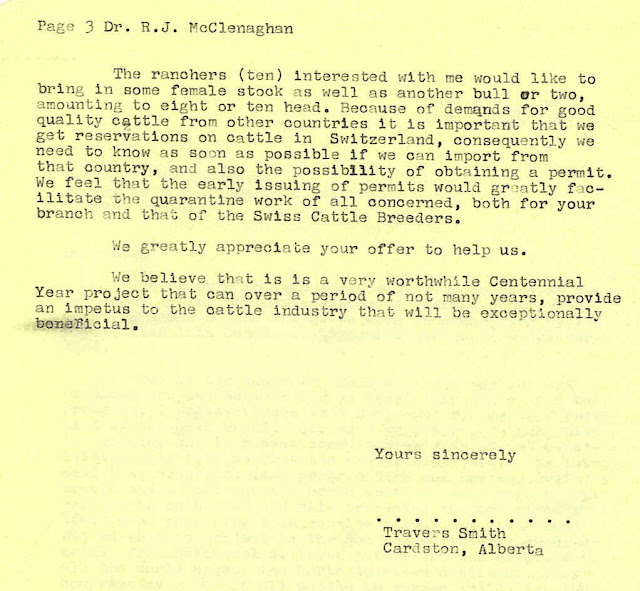▪ Jan 30: Fenton Webster writes to MP David Thompson in Ottawa for assistance in Swiss importation
▪ Jan. 31: Travers receives telegram from CSwissCBF about cattle selections
▪ Feb. 1: FW telephones MP and records notes of conversation
▪ Feb. 6: Letter from CDA-Vets re Swiss. situation
▪ Feb. 9: Letter from CSwissCBF
▪ Feb. 14: Letter from CDA acknowledging request for permit for importing cattle from Switzerland
▪ Feb 27: Letter from CDA re final costs of 1966 importation of Parisien
▪ Mar. 1: Letter from CSwissCBF updating situation on tentative imports
▪ Mar. 2: Letter from Swiss Federal Vets to CDA
▪ Mar. 3: Letter from CDA concerning release date from Grosse-Ile for 1966/67 import, Parisien
▪ Mar. 6: Letter to Travers from J.J. Greene, Canada Minister of Agriculture advising of intended visit of Senior Veterinary official’s visit to Switzerland and France in early May.
▪ Mar. 7: CDA Letter to Swiss Federal Vets concerning importation matters
▪ Mar. 8: Letter from CDA acknowledging receipt of Travers’ permit request for “three head of Simmental cattle from Switzerland in 1967 ....”
▪ Mar. 10: Letter to CDA re concerns about delayed release of 1966/67 imports
▪ Mar. 14: Letter from CDA replying to Mar. 10 letter
▪ Mar. 18: Swiss Federal Vets letter to CDA
▪ Mar. 21; CDA letter to Travers re on-farm quarantine protocol
▪ Mar. 23: CDA letter to Travers re his March 16 query about possible Ag. Research interest in Simmental
▪ Mar. 29: 2nd page of CSwissCBF letter to Travers re progress update
▪ Apr. 28: CDA-Vets letter to CswissCBF advising of delayed visit and acknowledging complications that it creates for Switzerland and importers
▪ May 2: Letter to Travers from CDA advising that a final decision had not been made, but accompanied by a 7-page “1967 Conditions for the Importation of Cattle from France, Switzerland approved by the Veterinary Director General, Health of Animals Branch, Canada Department of Agriculture
▪ May 11: Letter to CDA from CSwissCBF about May 15 visit and attempts to delay vaccination of selected cattle
▪ May 16: CDA reply to above
▪ May 16: Letter from CDA to Alberta Vet re insemination protocol of quarantined animals
▪ Jun 22: Letter from CDA to Travers re the “group” import requests
▪ Jul. 19: Permit letters for importation to Travers, B.Y. Williams, Hans Ulrich, Frank R. Smith, Harold Watson, H.J. Blackmore, O.T. Bingham, S.B. Williams; and copy of actual permit issued to “Mr. Travers Smith”
▪ Jul. 20: Telegram to Travers advising of import permit
▪ Aug. 25: Letter from S.E.P.A. re Parisien registration papers




















































